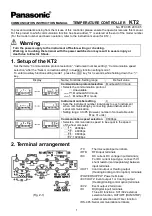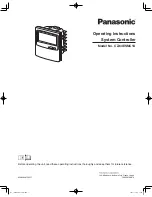
English (GB)
18
Max. 100 % [s] will define the maximum dosing time with a
controller output of 100 %. The unit is [s].
To change the maximum dosing time select Max. 100 % [s] with
[Up]- and [Down] buttons and by pressing [OK] button the
maximum dosing time can be changed with [Up]-, [Down]-, [Left]-
and [Right] button. Pressing [OK] button will confirm the new
value for the maximum dosing time.
Disturb. defines the source for the disturbance control. Following
inputs are possible:
– Analog outputs (4-20 mA)
– Digital outputs (PULSES or PWM)
D. factor is a multiplicative factor.
The function of the disturbance control is defined by following
equation:
Controller output value with disturbance control = controller
output value * Source value * Disturb.
For example if the controller output value is 50 %, Source is
Analog Input with 1.2 mA and the disturbance factor is 0.5 the
new controller output is
Controller output value with disturbance control = 50 [%] * 1.2
[mA] * 0.5 [1/mA] = 30 [%]
To map the disturbance control to an input (parameter), select
Disturb. with [Up]- and [Down] buttons and by pressing [OK]
button the input can be changed with [Up]- and [Down] buttons.
Pressing [OK] button confirms the input for disturbance control.
To change the disturbance factor select D. factor with [Up]- and
[Down] buttons and by pressing [OK] button the disturbance
factor can be changed with [Up]-, [Down]-, [Left]- and [Right]
button. Pressing [OK] button will confirm the new value for the
disturbance factor.
Direction defines the direction of the controller.
If it is up the controller increase controller output if setpoint
is above the parameter and decrease controller output if setpoint
is below the parameter.
If it is down the controller decrease controller output if setpoint is
above the parameter and increase controller output if setpoint is
below the parameter.
To change the direction of the controller, select Direction with
[Up]- and [Down] buttons and by pressing [OK] button up and
down can be toggled with [Up]- and [Down] buttons. Pressing
[OK] button confirms the new direction of the controller.
Deadband: If one parameter, for example Temp. is used for
controlling the temperature a dead band has to be defined to
avoid repeated activation-deactivation cycles (Hunting, see figure
below.)
Fig. 8
To change the level of the deadband select Deadband with [Up]-
and [Down] buttons and by pressing [OK] button the level of the
deadband can be changed with [Up]-, [Down]-, [Left]- and [Right]
button. Pressing [OK] button will confirm the new value for the
level of the deadband.
9.4.3 Settings 2-P
To change the type of the controller select Type with [Up]- and
[Down] buttons and by pressing [OK] button the type can be
toggled between PID, 2-P or none with [Up]-, [Down] buttons.
Pressing [OK] button will confirm the type.
None as a type will deactivate the controller.
Hysteresis defines the hysteresis for the 2-P-controller.
The switching points for the controller are:
Setpoint ± Hysteresis
To change the hysteresis of the controller select Hysteresis with
[Up]- and [Down] buttons and by pressing [OK] button the
hysteresis of the controller can be changed with [Up]-, [Down]-,
[Left]- and [Right] button. Pressing [OK] button will confirm the
new value for the hysteresis.
If Stop on Error is Yes the controller will stop if a sensor device
error occurs. The status of the controller changes to Stopped.
To change the behavior of the controller when an error occurs,
select Stop on Error with [Up]- and [Down] buttons and by
pressing [OK] button Yes and No can be toggled with [Up]- and
[Down] buttons. Pressing [OK] button confirms the new behavior.
If Stop on Alarm is Yes the controller will stop if an Alarm occurs.
The status of the controller changes to Stopped.
The Alarm limits can be set in the Alarm menu found in the
Parameter menu.
To change the behaviour of the controller when an alarm occurs,
select Stop on Alarm with [Up]- and [Down] buttons and by
pressing [OK] button Yes and No can be toggled with [Up]- and
[Down] buttons. Pressing [OK] button confirms the new
behaviour.
Max. 100 % [s] will define the maximum dosing time with a
controller output of 100 %. The unit is [s].
To change the maximum dosing time select Max. 100 % [s] with
[Up]- and [Down] buttons and by pressing [OK] button the
maximum dosing time can be changed with [Up]-, [Down]-, [Left]-
and [Right] button. Pressing [OK] button will confirm the new
value for the maximum dosing time.
Disturb. defines the source for the disturbance control. Following
inputs are possible:
– Analog outputs (4-20 mA)
– Digital outputs (PULSES or PWM)
D. factor is a multiplicative factor.
The function of the disturbance control is defined by following
equation:
Controller output value with disturbance control = controller
output value * Source value * Disturb.
For example if the controller output value is 50 %, Source is
Analog Input with 1.2 mA and the disturbance factor is 0.5 the
new controller output is
Controller output value with disturbance control = 50 [%] * 1.2
[mA] * 0.5 [1/mA] = 30 [%]
To map the disturbance control to an input (parameter), select
Disturb. with [Up]- and [Down] buttons and by pressing [OK]
button the input can be changed with [Up]- and [Down] buttons.
Pressing [OK] button confirms the input for disturbance control.
To change the disturbance factor select D. factor with [Up]- and
[Down] buttons and by pressing [OK] button the disturbance
factor can be changed with [Up]-, [Down]-, [Left]- and [Right]
button. Pressing [OK] button will confirm the new value for the
disturbance factor.
Direction defines the direction of the controller.
T
M
06
59
60
03
16
Output
Deadband
Heating
output
Cooling
output
Target
value
PV
0
∨
C2 Settings
►
Type:
2-P
Hysteresis
0.05
Disturb.:
DI 1
D. factor:
50.0
Direction:
up















































